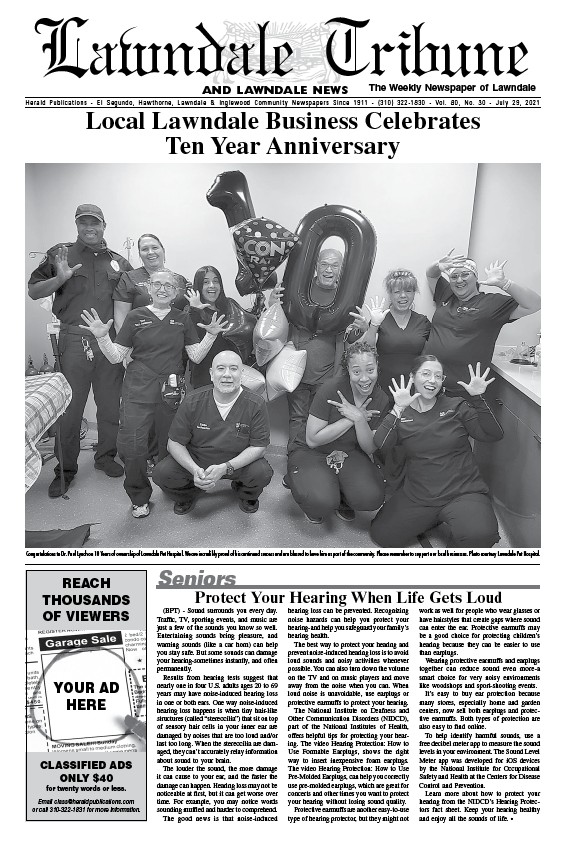
Lawndale Tribune
AND lAwNDAle News
The Weekly Newspaper of Lawndale
Herald Publications - El Segundo, Hawthorne, Lawndale & Inglewood Community Newspapers Since 1911 - (310) 322-1830 - Vol. 80, No. 30 - July 29, 2021
Local Lawndale Business Celebrates
Seniors
Protect Your Hearing When Life Gets Loud
(BPT) - Sound surrounds you every day.
Traffic, TV, sporting events, and music are
just a few of the sounds you know so well.
Entertaining sounds bring pleasure, and
warning sounds (like a car horn) can help
you stay safe. But some sounds can damage
your hearing-sometimes instantly, and often
permanently.
Results from hearing tests suggest that
nearly one in four U.S. adults ages 20 to 69
years may have noise-induced hearing loss
in one or both ears. One way noise-induced
hearing loss happens is when tiny hair-like
structures (called “stereocilia”) that sit on top
of sensory hair cells in your inner ear are
damaged by noises that are too loud and/or
last too long. When the stereocilia are damaged,
they can’t accurately relay information
about sound to your brain.
The louder the sound, the more damage
it can cause to your ear, and the faster the
damage can happen. Hearing loss may not be
noticeable at first, but it can get worse over
time. For example, you may notice words
sounding muffled and harder to comprehend.
The good news is that noise-induced
hearing loss can be prevented. Recognizing
noise hazards can help you protect your
hearing-and help you safeguard your family’s
hearing health.
The best way to protect your hearing and
prevent noise-induced hearing loss is to avoid
loud sounds and noisy activities whenever
possible. You can also turn down the volume
on the TV and on music players and move
away from the noise when you can. When
loud noise is unavoidable, use earplugs or
protective earmuffs to protect your hearing.
The National Institute on Deafness and
Other Communication Disorders (NIDCD),
part of the National Institutes of Health,
offers helpful tips for protecting your hearing.
The video Hearing Protection: How to
Use Formable Earplugs, shows the right
way to insert inexpensive foam earplugs.
The video Hearing Protection: How to Use
Pre-Molded Earplugs, can help you correctly
use pre-molded earplugs, which are great for
concerts and other times you want to protect
your hearing without losing sound quality.
Protective earmuffs are another easy-to-use
type of hearing protector, but they might not
work as well for people who wear glasses or
have hairstyles that create gaps where sound
can enter the ear. Protective earmuffs may
be a good choice for protecting children’s
hearing because they can be easier to use
than earplugs.
Wearing protective earmuffs and earplugs
together can reduce sound even more-a
smart choice for very noisy environments
like woodshops and sport-shooting events.
It’s easy to buy ear protection because
many stores, especially home and garden
centers, now sell both earplugs and protective
earmuffs. Both types of protection are
also easy to find online.
To help identify harmful sounds, use a
free decibel meter app to measure the sound
levels in your environment. The Sound Level
Meter app was developed for iOS devices
by the National Institute for Occupational
Safety and Health at the Centers for Disease
Control and Prevention.
Learn more about how to protect your
hearing from the NIDCD’s Hearing Protectors
fact sheet. Keep your hearing healthy
and enjoy all the sounds of life. •
Ten Year Anniversary
Congratulations to Dr. Paul Lynch on 10 Years of ownership of Lawndale Pet Hospital. We are incredibly proud of his continued success and are blessed to have him as part of the community. Please remember to support our local businesses. Photo courtesy Lawndale Pet Hospital.
Reach
thousands
of viewers
YOUR AD
HERE
Classified Ads
only $40
for twenty words or less.
Email class@heraldpublications.com
or call 310-322-1831 for more information.